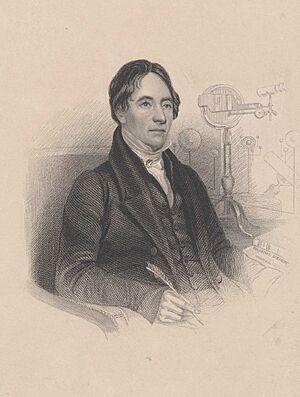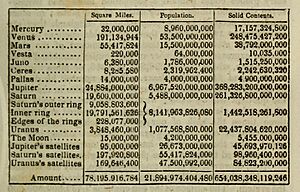Thomas Dick (scientist) facts for kids
Quick facts for kids
Rev. Thomas Dick
|
|
|---|---|
 |
|
| Born | 24 November 1774 Hilltown, Dundee
|
| Died | 29 July 1857 (age 82) |
| Nationality | Scottish |
| Scientific career | |
| Fields | Astronomy, Christian ministry |
| Signature | |
Reverend Thomas Dick (born November 24, 1774 – died July 29, 1857) was a Scottish church minister, science teacher, and writer. He was famous for his books about astronomy and philosophy. He believed that science and Christianity worked together in harmony.
Contents
About Thomas Dick
His Early Years
Thomas Dick grew up in Scotland in a strict Presbyterian family. His father, Mungo Dick, made linen cloth and wanted Thomas to follow in his footsteps.
When Thomas was nine, he saw a bright meteor. This event made him very interested in astronomy. He read every book he could find about the stars, even while working. He even made his own telescope lenses from old glasses. His parents eventually let him choose his own path when he was sixteen.
Learning and Teaching
Dick became a helper at a school in Dundee. In 1794, he went to the University of Edinburgh. He paid for his studies by teaching other students.
After finishing his studies, he opened a school in Dundee. He also became a preacher in 1801. Later, he moved to Methven and taught at a school there for ten years. During this time, he worked hard to help people learn more. He strongly encouraged the study of science. He also started a "people's library" and a type of club for working people to learn. He wrote articles in a magazine in 1814, suggesting that more such learning groups should be created.
At university, Thomas Dick had classmates who became famous. These included Robert Brown, a botanist, and Joseph Black, a chemist.
Becoming an Author
After Methven, Dick taught in Perth for another ten years. During this time, he published his first book. It was called The Christian Philosopher, or the Connexion of Science and Philosophy with Religion, and it came out in 1823.
This book was very popular and had many new editions. Its success helped Dick decide to become a full-time writer. In 1827, he stopped teaching school. He built a small house with an observatory and a library in Broughty Ferry, near Dundee. From there, he wrote many books about science, philosophy, and religion. These books became very popular in the United Kingdom and the United States.
Thomas Dick believed that every planet in our Solar System had living beings. This idea is called cosmic pluralism. In his book Celestial Scenery, he even calculated that the Solar System could have over 21 trillion inhabitants! He figured this out by using the size of each planet and the population density of England. One of his articles, where he wondered about talking to people on the Moon, even inspired a famous newspaper trick called the Great Moon Hoax.
It's important to know that Thomas Dick himself did not support the Moon Hoax. He actually spoke out against it.
Dick also worked with the Religious Tract Society. They published some of his books about science and religion. One of his most successful books was The Telescope and Microscope.
He received an honorary degree from Union College in New York. He also became a member of the Royal Astronomical Society in 1853.
His Final Years
Even though his books were popular, Thomas Dick did not earn much money from them. He made agreements with publishers that didn't pay him well. In 1847, he received a small yearly payment and some local donations to help him. He passed away on July 29, 1857, at 82 years old. He was buried in Broughty Ferry.
His Impact
Thomas Dick's books helped spread the ideas of the Scottish Enlightenment. They also connected these ideas with the religious thinking of the Victorian era. His writings influenced many important people, including scientists, engineers, and writers. For example, David Livingstone, a famous explorer and missionary, said that Dick's book Philosophy of a Future State was very important to him, second only to the Bible.
In 1851, Thomas Dick met William Wells Brown, an American writer and abolitionist. Brown later described Dick as someone who hated slavery.
An Asteroid in space, called (9855) Thomasdick, is named after Thomas Dick.
What He Wrote
Here are some of Thomas Dick's important books:
- The Christian Philosopher, or the Connection of Science with Religion (1823): This was his first popular book.
- The Philosophy of a Future State (1829): In this book, he explored Christian ideas that fit with scientific thinking.
- The Mental Illumination and Moral Improvement of Mankind (1836): This book shared his thoughts on how to improve people's minds and morals.
- Celestial scenery; or, The wonders of the planetary system displayed; illustrating the perfections of deity and a plurality of worlds (1838): This book showed the amazing things in our solar system and argued that other planets might have life.
- The Sidereal Heavens, and other subjects connected with Astronomy (1840, 1850): This book also presented reasons for believing in life on other worlds.
- The Practical Astronomer (1845): This book gave simple instructions on how to use astronomy tools. He also wrote smaller books for the Religious Tract Society, like those on the Telescope and Microscope, The Atmosphere and Atmospheric Phenomena, and The Solar System.


